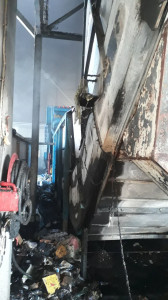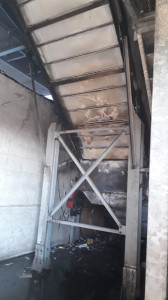A fire started at a waste sorting facility at around 11.30 a.m. The fire alarm went off. Two workers saw flames in a four-wheeled bin under a conveyor and on the conveyor. They pushed the bin out of the building and attacked the flames with a fire extinguisher. Thick black smoke billowed from the conveyor’s rubber belt. The sprinklers above the feed hopper came on. All the workers went to the assembly point.
The firefighters asked the operator to cut off the electricity. The fire was brought under control Two smoke vents were opened. At around 2:00 p.m., the site was completely de-energised when padlocks were fitted on the two disconnect switches on the low-voltage transformer. A tarpaulin was placed over the electrical cabinets to protect them from water dripping from the ceiling. The sprinkler system’s water valve was shut off. The gendarmes conducted a patrol at around 4:00 p.m. The facility was monitored over the weekend.
Five workers and two firefighters were sickened by the smoke. Their blood carbon monoxide levels were monitored. Access to the processing area was prohibited for 48 hours to allow the concrete in the wall to fully cool and release the carbon monoxide it had absorbed as it heated up.
The fire damaged the conveyor belt, electrical wiring, detection system, wall lights, sprinkler heads and stormwater downpipes. A contractor surveyed the conveyor’s condition.
The firewater was contained in a pond and pumped out by a specialist contractor.
The fire may have been caused by welding and grinding operations carried out that morning by a contractor. The flames appeared near the site of the operations 15 minutes after they ended. Glowing particles may have been thrown and come into contact with material trapped in the interstices of the conveyor structure (conglomeration of paper fibres, cardboard and plastics). The fire smouldered and then the first flames appeared.
The fire enabled the operator to identify areas for improving the organisation fire safety at the facility (handling of fire-hose reels, extension of the sprinkler network, etc.). He amended the hot-spot work procedure:
- the area must be watered prior to work;
- the conveyor must be watered after work;
- a fire watch must be posted for two hours after work is completed;
- two members of the contractor’s staff (instead of one) must take part in this type of work.





